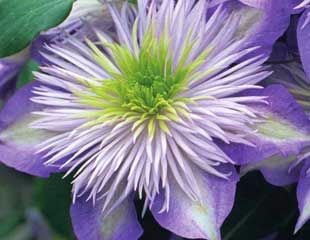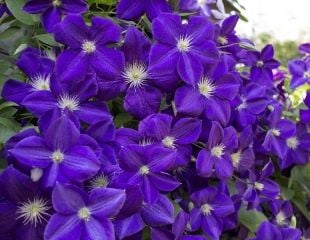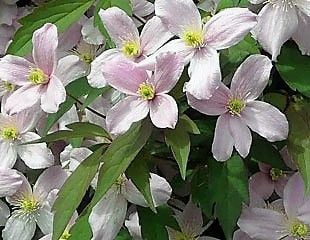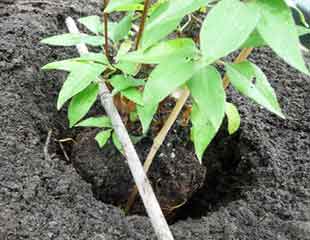


How to Plant, Grow and Prune Clematis
Clematis are easy to grow because they are a vigorous climber. Most are fully hardy and tolerant of many soil types and conditions. Clematis are mostly sun loving and flower best with plenty of sun, which means 6 hours plus per day. Plant in good, fertile, organically rich soil for best results. Ideally, even though Clematis needs to be planted in a sunny spot, they grow best if their roots are shaded.
Clematis can be tricky to grow because of the pruning regime. All Clematis in groups 2 & 3 need pruning every year to maintain shape and to keep them flowering. For this reason I have tagged Clematis, an "amber wheel barrow plant" showing medium difficulty to grow. The new foliage is very attractive to slugs, and Clematis need protection. Tips on how best to protect Clematis from slugs. Lastly, Clematis can be subject to a disease called Clematis wilt, by which the leaves turn brown and look unsightly.
On the positive side, Clematis is a lovely climbing plant with a wide range of flower shapes, sizes, colours and flowering times. The Pinterest page and Types of Clematis illustrate the many diverse shapes and sizes of Clematis, with new varieties being introduced every year and many are scented. (affiliate link to Crocus scented Clematis.)
The easiest Clematis to grow, because they need little or no pruning, are Clematis montana, C. alpina and C. macropetala. One of the loveliest varieties, Clematis montana 'Elizabeth' has a beautiful vanilla scent. When planting a Clematis montana you need a large space as many varieties are vigorous, growing up to 15m (nearly 50ft) if left unchecked and growing in ideal conditions. However, there are now varieties of Clematis montana which are less vigorous and manageable in the average sized garden- check out Types of Clematis for more information.
The different varieties of Clematis have a long flowering season, starting early in the year with the C. alpina right through to September the late flowering C. Tangutica, and over winter C. Cirrhosa. Clematis like well-drained soil with sun or light shade. There are some Clematis varieties which are more shade tolerant listed below.
How to Plant Clematis

It is important to plant Clematis to the correct depth. You can plant Clematis during Spring, Summer or autumn. Selecting a good weather spell and rain after planting is helpful, providing it is not a mini monsoon.
Most clematis prefer full sun, with plenty of organic matter so add into the planting hole peat free compost, leaf mould or well-rotted manure whichever is to hand. Digging in extra organic material will also ensure that the bottom of the planting hole is not compacted, allowing the Clematis to easily establish its roots.
The golden rule when planting a Clematis is to make sure that the root ball sits at least 5cms below the soil level - see image left. This is beneficial to the plant and helps to stop Clematis wilt. The easiest way to make sure you have the correct depth is to lay a bamboo cane across the hole so you can see the line of the soil depth and check the Clematis is at least 5cms below the soil level. Fill in, water and protect young growth from slugs. Clematis thrive with shaded roots, but need sun elsewhere—a difficult combination to achieve.
The exception to this rule is the winter flowering clematis, such as Clematis cirrhosa which are planted with the top of the root ball at soil level.
You can protect and shade the roots by the leaves of adjacent plants, such as a large leaf Hosta or by a physical barrier such as a slate, plus mulch will help to keep the roots cooler. In common with all new plants, water well after planting. A newly planted Clematis will benefit from cutting all shoots down to 15 -30cms the first year only. Watch the Sunday Gardener video How to plant Clematis.
If you want to plant Clematis in a container, it is best to choose one of the less vigorous varieties. There is a wide range of smaller Clematis on sale, including those described as "Patio Clematis" which are ideal for containers. The large, very vigorous growers such as C. montana are not suitable for growing in containers.
How to Prune a New Clematis
Newly planted Clematis are all pruned in the same way, which makes the immature plant produce several stems. Check it when you buy it, and if the plant already has multiple, that is 3-5 stems, growing from the base, it does not need pruning it's already in good shape. This is often the presentation of a more mature plant where the nursery has done the formative pruning.
If the new clematis is a single stem, prune it back hard the first spring to a pair of buds around 30cms from the ground. Within a short period, it will throw out new shoots which can be trained into shape. After the first year prune according to its group.
More about Growing Clematis
Once you have planted your Clematis the next step is how and when to prune it. To prune it, you need to know to which pruning group your particular Clematis belongs too. Easy if you have the label, less easy if you have lost the label or acquired the Clematis in a garden which you didn't plant and don't know what it is.
Next steps
Pruning Groups 1, 2 & 3 explained plus How to Prune Clematis.
